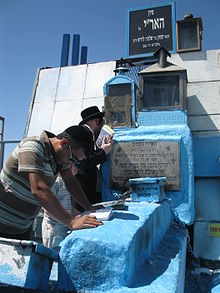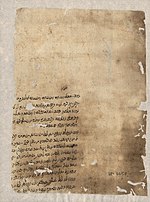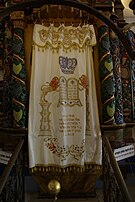Isaac Luria
Rabbi Isaac Luria | |
|---|---|
 The grave of Isaac Luria in Safed | |
| Title | Ha'ARI Ha'ARI Hakadosh ARIZaL |
| Personal | |
| Born | 1534 |
| Died | July 25, 1572 (aged 37–38) (5 Av 5332 AM) Safed, Damascus Eyalet, Ottoman Syria, Ottoman Empire |
| Religion | Judaism |
| Signature |  |
| Buried | Old Cemetery of Safed |
Isaac ben Solomon Luria Ashkenazi (Hebrew: יִצְחָק בן שלמה לוּרְיָא אשכנזי; c. 1534[1] – July 25, 1572[2]), commonly known in Jewish religious circles as Ha'ari[a], Ha'ari Hakadosh[b] or Arizal,[c] was a leading rabbi and Jewish mystic in the community of Safed in the Galilee region of Ottoman Syria, now Israel. He is considered the father of contemporary Kabbalah,[5] his teachings being referred to as Lurianic Kabbalah.
While his direct literary contribution to the Kabbalistic school of Safed was extremely minute (he wrote only a few poems), his spiritual fame led to their veneration and the acceptance of his authority. The works of his disciples compiled his oral teachings into writing. Every custom of Luria was scrutinized, and many were accepted, even against previous practice.[4]
Luria died at Safed on July 25, 1572, and is buried at the Old Jewish Cemetery, Safed.[4][2] The Ari Ashkenazi Synagogue, also located in Safed, was built in memory of Luria during the late 16th century.[6]
Early life
[edit]| Part of a series on |
| Kabbalah |
|---|
 |

Luria was born in 1534 in Jerusalem[1] in what is now the Old Yishuv Courtyard[4] to an Ashkenazi father, Solomon, and a Sephardic mother.[7]
Sefer HaKavanot U'Ma'aseh Nissim records that one day, Luria's father remained in the synagogue alone, studying, when the prophet Elijah appeared to him and said, "I have been sent to you by the Almighty to bring you tidings that your holy wife shall conceive and bear a child, and that you must call him Yitzchak. He shall begin to deliver the believers from the qlippoth. Through him, numerous souls will receive their tikkun. He is also destined to reveal many hidden mysteries in the Torah and to expound on the Zohar. His fame will spread throughout the world. Take care therefore that you not circumcise him before I come to be the Sandak [who holds the child during the brit milah ceremony]."[4]
While still a child, Luria lost his father and was raised by his rich maternal uncle Mordechai Frances, a mültazim (tax farmer) from Cairo in Ottoman Egypt. His uncle placed him under the best Jewish teachers, including the leading rabbinic scholar David ben Solomon ibn Abi Zimra.[7] Luria showed himself a diligent student of rabbinical literature and under the guidance of another uncle, Bezalel Ashkenazi, best known as the author of the Gathered Method (Hebrew: שיטה מקובצת), he became proficient in that branch of Jewish learning.[8]
At the age of fifteen he married a cousin, the daughter of Mordechai Frances, and being amply provided for financially he was able to continue his studies. Around the age of twenty-two he became engrossed in the study of the Zohar, a major work of the Kabbalah that had recently been printed for the first time, and adopted the life of a recluse. Retreating to the banks of the Nile for seven years, he secluded himself in an isolated cottage, giving himself up entirely to meditation. He visited his family only on Shabbat. But even at home, he would not utter a word, even to his wife. When it was necessary for him to say something, he would say it in the fewest words possible,[4] and then, only in Hebrew.[9]
Teachings
[edit]
In 1569, Luria moved back to the Jerusalem Sanjak, and after a short sojourn there, where his new kabbalistic system seemed to have met with little success, he settled in the Safed Sanjak. Safed in the Galilee had become a center for kabbalistic studies over the previous decades, led by Moses ben Jacob Cordovero.[10][11] There is evidence that Luria also regarded Cordovero as his teacher. Joseph Sambari (1640–1703), an Egyptian chronicler, testified that Cordovero was "the Ari's teacher for a very short time."[12] Luria probably arrived in early 1570, and Cordovero died on June 27 that year (the 23d day of Tammuz).[13] Bereft of their most prominent authority and teacher, the community looked for new guidance, and Luria helped fill Cordovero's former role.[citation needed]
Soon Luria had two classes of disciples: novices, to whom he expounded elementary kabbalah, and initiates, who became the repositories of his secret teachings and his formulas of invocation and conjuration. The most renowned of the initiates was Hayyim ben Joseph Vital, who, according to his master, possessed a soul that Adam's sin had not soiled.[11] With him, Luria visited the grave of Shimon bar Yochai and those of other eminent teachers; it is said that these graves were unmarked, but through the mystical guidance given by Elijah, each grave was recognized.
Luria's kabbalistic circle gradually widened and became a separate congregation in which his mystic doctrines were supreme, influencing all the religious ceremonies. On Shabbat, Luria dressed himself in white and wore a fourfold garment to signify the four letters of the Tetragrammaton.[citation needed]
Many Jews who had been exiled from Spain following the Edict of Expulsion believed they were in the time of trial that would precede the appearance of the Messiah in Galilee. Those who moved to Damascus Eyalet in anticipation of this event found a great deal of comfort in Luria's teachings due to his theme of exile. Although he did not write down his teachings, they were published by his followers and by 1650 his ideas were known by Jews throughout Europe.[14]
Luria delivered his lectures spontaneously, without ever writing down his ideas (with a few exceptions, including kabbalistic poems in rabbinical Aramaic for the Shabbat table). The foremost advocate of his kabbalistic system was Vital, who collected all the disciples' lecture notes. Numerous works were produced from these notes, the most important of which was the Etz Chaim, "Tree of Life", in eight volumes (see below). Originally, it circulated only in manuscript copies. Each of Luria's disciples had to pledge—under pain of excommunication—not to allow any copy be made for a foreign country, so that for a time all the manuscripts remained in Ottoman Syria. Eventually, one was brought to Europe and was published at Zolkiev in 1772 by Isaac Satanow.[11] In this work, both the theoretical and the devotional-meditative teachings of Lurianic Kabbalah, based on the Zohar, are elaborated upon.[citation needed]
Tzimtzum was one of Luria's most important ideas that he stressed in his lectures.[3]
Disciples
[edit]Notes
[edit]- ^ Hebrew: האר"י, meaning "the Lion"; derived from the acronym for "Elohi Rabbi Itzhak" (the Godly Rabbi Isaac) or "Adoneinu Rabbeinu Isaac" (our master, our rabbi, Isaac). Sometimes known as the Ari in English.[3]
- ^ Hebrew: האר"י הקדוש, meaning "the Holy Lion"
- ^ Hebrew: אר״י ז״ל, meaning "the Lion of Blessed Memory"[4]
Citations
[edit]- ^ a b Fine 2003, p. 24
- ^ a b Green, David B. (July 25, 2016). "1572: Father of Lurian kabbala and confidant of Elijah dies". Haaretz. Retrieved July 25, 2021.
- ^ a b Falcon, Ted; Blatner, David (2019). Judaism for Dummies (2nd ed.). Hoboken, New Jersey: John Wiley & Sons, Inc. p. 76. ISBN 978-1-119-64307-4. OCLC 1120116712.
- ^ a b c d e f "Rabbi Yitzchak Luria Ashkenazi". Ascent of Safed. Archived from the original on January 8, 2009. Retrieved January 2, 2009.
{{cite web}}: CS1 maint: unfit URL (link) - ^ Eisen, Yosef (2004). Miraculous Journey: A Complete History of the Jewish People from Creation to the Present (Rev. ed.). Southfield, Mich.: Targum Press. p. 213. ISBN 1568713231. Retrieved December 2, 2018.
- ^ Isaacson, Judith; Rosenbloom, Deborah (1998). Bar and Bat Mitzvah in Israel: The Ultimate Family Sourcebook. Israel Info-Access. p. 59. ISBN 9780966087703.
- ^ a b Fine 2003, Fine, Lawrence (2003). Physician of the Soul, Healer of the Cosmos: Isaac Luria and his Kabbalistic Fellowship. Stanford University Press. p. 29. ISBN 978-0-8047-4826-1.
- ^ Fine 2003 Fine, Lawrence (2003). Physician of the Soul, Healer of the Cosmos: Isaac Luria and his Kabbalistic Fellowship. Stanford University Press. pp. 31–32. ISBN 978-0-8047-4826-1.
- ^ "The Essence". Archived from the original on January 8, 2009.
- ^ Fine 2003, Fine, Lawrence (2003). Physician of the Soul, Healer of the Cosmos: Isaac Luria and his Kabbalistic Fellowship. Stanford University Press. ISBN 978-0-8047-4826-1.
- ^ a b c "Isaac ben Solomon Ashkenazi Luria (ARI)". JewishEncyclopedia.com. Retrieved December 2, 2018.
- ^ Sambari 1673, p. 64
- ^ Fine 2003, pp. 80-81
- ^ Armstrong, Karen (2001). The Battle for God: A History of Fundamentalism. Ballantine Books. pp. 8–14.
References
[edit]- Fine, Lawrence (2003). Physician of the Soul, Healer of the Cosmos: Isaac Luria and His Kabbalistic Fellowship. Stanford, CA: Stanford University Press. p. 480. ISBN 0-8047-4826-8. Retrieved December 2, 2018.
- Klein, Eliahu (2005). Kabbalah of Creation: The Mysticism of Isaac Luria, Founder of Modern Kabbalah. Berkeley: North Atlantic Books. ISBN 1-55643-542-8.
- Avivi, Yosef (2008). Kabbala Luriana (in Hebrew). Vol. 3. Jerusalem: Ben Zvi Institute. ISBN 978-965-235-118-0.
- Joseph ben Isaac Sambari (1994) [1-23-1673]. Sefer Divrei Yosef. Jerusalem: Ben Zvi Institute.
- Dunn, James David (2008). Window of the Soul. The Kabbalah of Rabbi Isaac Luria. San Francisco, CA/Newburyport, MA: WeiserBooks. ISBN 978-1-57863-428-6.
External links
[edit]- Shaarei Kedushah - Gates of Holiness in English
- Orthodox Union page on Rabbi Isaac Luria – The Ari
- Short biography of Rabbi Isaac Luria – The Ari Hakodosh
- Video lecture on Rabbi Isaac Luria by Dr. Henry Abramson
- Letter, written and signed by Isaac Luria, from the Cairo Genizah
- Traditional Sphardi Singing of Luria's Yom Zeh L'Yisrael
- Centre for Lurian Kabbalah
- Chisholm, Hugh, ed. (1911). . Encyclopædia Britannica (11th ed.). Cambridge University Press.
